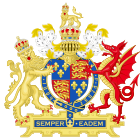| Act of Parliament | |
 | |
| Long title | An act against Jesuits, seminary priests, and such other like disobedient persons. |
|---|---|
| Citation | 27 Eliz. 1. c. 2 |
| Dates | |
| Repealed | 9 August 1844 |
| Other legislation | |
| Repealed by | Roman Catholics Act 1844 |
Status: Repealed | |
| Revised text of statute as amended | |
An act against Jesuits, seminary priests, and such other like disobedient persons, also known as the Jesuits, etc. Act 1584, (27 Eliz. 1. c. 2) was an Act of the Parliament of England passed during the English Reformation. The Act commanded all Roman Catholic priests to leave the country within 40 days or they would be punished for high treason, unless within the 40 days, they swore an oath to obey the Queen. Those who harboured them, and all those who knew of their presence and failed to inform the authorities, would be fined and imprisoned for felony, or if the authorities wished to make an example of them, they might be executed for treason.[1]
Anyone who was brought up as a Jesuit overseas (i.e. if they were educated abroad in a Jesuit seminary) had to return to England within six months, and then within two days of arriving swear to submit to the Queen and also take the oath required by the Act of Supremacy 1558. Failure to do so was treason. Any person who did take the oath was forbidden from coming within 10 miles of the Queen for 10 years unless they had her personal written permission. Again, failure to observe this requirement was treason.[2] Priests already within England had 40 days to depart, although this was by grace, not a right, and could be withdrawn, as it was for example during the Popish Plot.[3]
- ^ Medley, Dudley J. (1925). A student's manual of English constitutional history (6th ed.). New York: Macmillan. pp. 638–639. hdl:2027/uc1.$b22458. OCLC 612680148. Retrieved 22 October 2014.
- ^ Pollen, J. H. (March 1922). "The Elizabethan act that made martyrs". The Month. 139 (693). London su.a.]: Longmans, Green: 236–245. ISSN 0027-0172. Retrieved 22 October 2014.
- ^ Kenyon 2000 p.121